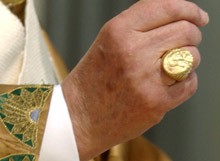 Today, (February 28, 2013) is a significant day for Roman Catholics worldwide as the current Pope steps aside, the first time a Pope has done so in almost 600 years. A number of symbolic ceremonies will mark the occasion including the breaking of the Papal ring, called the Ring of the Fisherman, also known as the Piscatory Ring, Annulus Piscatoris (in Latin) and the Anello Piscatorio (in Italian). This is an official part of the regalia worn by the Pope, head of the Roman Catholic Church. As I am sure we are all aware, Rome claims that the Pope is the successor of the Apostle Peter, who by trade was a fisherman. The design of the ring features a bas-relief of Peter fishing from a boat. The Fisherman’s Ring was used until 1842 to seal official documents signed by the Pope.
Today, (February 28, 2013) is a significant day for Roman Catholics worldwide as the current Pope steps aside, the first time a Pope has done so in almost 600 years. A number of symbolic ceremonies will mark the occasion including the breaking of the Papal ring, called the Ring of the Fisherman, also known as the Piscatory Ring, Annulus Piscatoris (in Latin) and the Anello Piscatorio (in Italian). This is an official part of the regalia worn by the Pope, head of the Roman Catholic Church. As I am sure we are all aware, Rome claims that the Pope is the successor of the Apostle Peter, who by trade was a fisherman. The design of the ring features a bas-relief of Peter fishing from a boat. The Fisherman’s Ring was used until 1842 to seal official documents signed by the Pope.
Wikipedia says, “A new ring is cast in gold for each Pope. Around the relief image is the reigning Pope’s Latin name in raised lettering. During the ceremony of a Papal coronation or Papal inauguration, the Dean of the College of Cardinals slips the ring on the third finger of the new Pope’s right hand. Upon a papal death, the ring is ceremonially broken in the presence of other Cardinals by the Camerlengo, in order to prevent the sealing of backdated, forged documents during the interregnum, or sede vacante. This custom is also planned to be followed after the resignation of Pope Benedict XVI.”
With today’s events in mind, what follows is a question and answer repost of a blog article here regarding the question of Peter and the keys:
 Question: The Roman Catholic Church claims that the Apostle Peter was the first Pope. Much is made of Jesus giving Peter the keys of the kingdom. Do you have anything that would help me rightly understand this Matthew 16 passage?
Question: The Roman Catholic Church claims that the Apostle Peter was the first Pope. Much is made of Jesus giving Peter the keys of the kingdom. Do you have anything that would help me rightly understand this Matthew 16 passage?
Thank you for your question. It is a very important one. You are right to say that Roman Catholics make much of this passage claiming that it teaches Rome’s position on the Papacy in clear terms. In my opinion, the best treatment of the passage in question is found in Dr. James White’s book “The Roman Catholic Controversy.” The entire book is immensely helpful, and while written back in 1996, is just as relevant to the situation in our day. Roman Catholics, for all their claims, actually do not have history on their side in this debate. This article addresses this in summary form. However, regarding the Matthew 16 passage, rather than summarizing Dr. White’s words, let me quote directly from the book, from Chapter 8 “The Claims of the Papacy”, pages 115-118:
Few would argue that the foundational passage on which the entire Roman Catholic claim for the Papacy rests is found in Matthew 16:13-20, verses 18-19 in particular. We are told that their plain meaning supports the concept. It should be noted that Rome has infallibly interpreted these verses in the words of Vatican I. It is one of the few passages of Scripture that have in fact been infallibly interpreted by the Roman Catholic Church (John 21:25-27 being another). Let’s look at Matthew’s record.
He said to them, “But who do you say that I am?” Simon Peter answered, “You are the Christ, the Son of the living God.” And Jesus said to him, “Blessed are you, Simon Barjona, because flesh and blood did not reveal this to you, but My Father who is in heaven. I also say to you that you are Peter, and upon this rock I will build My church; and the gates of Hades will not overpower it. I will give you the keys of the kingdom of heaven; and whatever you bind on earth shall have been bound in heaven, and whatever you loose on earth shall have been loosed in heaven.”
No one will deny that this is a singularly important passage. Here the Lord Jesus leads His disciples to a confession of faith in himself; the Father from heaven reveals the true nature of His Son, Jesus Christ.
Yet we find these verses being used to support a concept seen nowhere else in Scripture. We are asked to believe that not only is the impetuous and frail Peter made the very foundation of the Church itself, but that this foundational position creates an office of Pope, and that this office involves successors who will sit in the seat of bishop in the city of Rome, 1,500 miles distant.
Before we can discuss this passage, it is necessary to address the claim often made by Roman Catholic apologists: They say that we should imagine how Matthew’s words would appear in Aramaic, assuming that they were spoken in that language. Some even go so far as to say that Matthew was originally written in Aramaic, the modern opinion on the subject has changed over the past decades. We could spend much time arguing about whether Matthew was written in Aramaic; I could cite Alexander Bruce 9, G. H. Schodde 10, D. A. Carson 11, and Robert Gundry 12. But I shall simply allow the leading New Testament scholar, Kurt Aland, to summarize my position: “There is no longer any doubt that Greek was the language in which all parts of the New Testament were originally written…” 13
Much has been said by Roman Catholic apologists about what Matthew 16:18 would read in Aramaic. Some have asserted with complete confidence that they can tell us exactly what the Aramaic would be. Yet, is it not strange that when dealing with the eternal passage used to support the Papacy, they must appeal to a nonexistent, unknown “Aramaic original” that no one – no matter how great their scholarship- can possibly claim to be able to re-create with certainty? 14
Anyone familiar with the comments of scholars on this passage is aware of the multitude of differing positions taken about it. I would first like to provide a straightforward interpretation of the verses, and then discuss some of the areas of dispute.
The central theme is the Messiahship of Jesus Christ. Any interpretation that takes the focus off of Jesus as Messiah is missing the point. Jesus’ questions to the disciples about the opinions of the multitudes, and then their own viewpoints, are all directed towards His own person, His own identity. When Peter speaks up and confesses that Jesus is the Christ, the Son of the living God, he is confessing the faith of all the disciples, not merely his own. He often spoke for them all. Jesus’ pronouncement of blessing upon Peter is not because of any inherent goodness in Peter but rather his being the recipient of a great blessing from the Father. To Peter has been revealed the true identity of Jesus Christ. And, of course, this revelation was given to the other Apostles as well. We can hardly think that they all sat there amazed at Peter’s words, never having thought that Jesus was the Christ, the Son of the living God. The point of Jesus’ words is that to reveal the Son requires the enlightening work of the Father. The same theme is seen in John 6, where no man can come to the Son unless drawn by the Father. In that same context, when all the disciples turned away from Jesus, save the twelve, it was Peter who spoke for the disciples again, saying, “Lord, to whom shall we go? You have the words of eternal life. We have believed and have come to know that You are the Holy One of God” (John 6:68-69, emphasis added).
When the Lord says, “I tell you that you are Peter, and on this rock I will build my church, and the gates of Hades will not overcome it,” the focus does not change. The subject of the passage remains the identity of Christ, found in the confession of Peter. Jesus is not speaking of the identity of Peter; He is still talking about Himself and His Church. This is evident by continuing on through verse 20, where we read, “Then He warned the disciples that they should tell no one that He was the Christ.” Some modern scholars, having missed the fact that the focus remains on Christ all the way through, are so puzzled by this passage that they suggest that it is not original. But such conjecture is not necessary.
The rock of which the Lord speaks is that common confession made by all who are part of the Church: Jesus is the Christ, the Son of the living God. 15 This is seen, I believe, in the fact that while the Lord is addressing Peter directly, he changes from direct address to the third person, “this rock,” when speaking of Peter’s confession. He does not say, “Upon you, Peter, I will build my church.” Instead, you have a clear distinction between Peter, the ?????? (Petros), and the demonstrative pronoun preceding ????? (petra), the confession of faith, on which the Church is built.
This statement is followed by the promise to give the keys of the kingdom of heaven to Peter at some time in the future, so that what he binds on earth will be bound in heaven, and whatever he looses on earth will be loosed in heaven. I emphasize this is a promise, for the verb is future in tense. 16 Yet when we see this authority given in Matthew 18:18, it is given not to Peter alone or even primarily to him. It is conferred on all the Apostles, using the exact same language 17 regarding binding and loosing. If someone wishes to say that Peter receives keys in distinction from the other Apostles, as their superior, they are forced to admit that the actual giving of these keys is never recorded for us anywhere in Scripture, a strange thing indeed for something supposedly so fundamental to the constitution of the Church.
Now, a Roman Catholic may disagree with my interpretation. But my interpretation makes perfect sense. It does not require leaps of illogic to see how I have come to my conclusions. This position has been held by Christians from the earliest days of the Christian faith. If the Roman Catholic Church can present an equally likely interpretation, I believe it would fail. Because, as we have seen, Matthew 16 is the last bastion 18 of the Roman cause. If concrete support for the Papacy is not here, then it is nowhere at all. And Rome cannot simply provide an alternative. She must be able to prove, beyond all question, the impossibility of all other interpretations. And she cannot do this.
Notations for the numerical citations above are found in Dr. White’s book (available from www.aomin.org).
